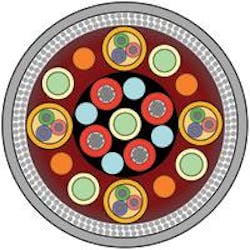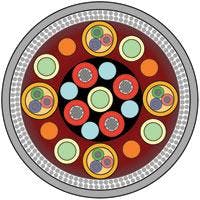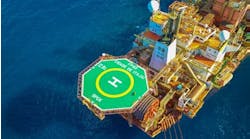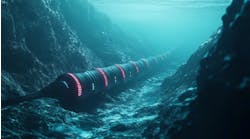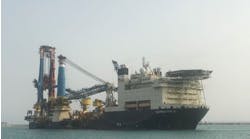Deepwater steel tube umbilicals (STUs) are generally a late procured item. Though a vital, high-tech component of the subsea architecture, early specification of umbilicals is not critical. In fact, on many projects, operators procure them on a piecemeal basis, then provided them to the installation contractor. But in deep and ultra-deepwater, there are a number of key issues warranting earlier consideration of umbilicals.
The crucial factor in deep and ultra-deepwater installation is to ensure that none of the cables, hydraulic fluids, or tubes in the steel tube umbilical (STU) deform to an unacceptable level under the high tension loads.
An in-depth analysis of the stresses created during installation can ensure that the necessary criteria for successful, fatigue-minimizing installation are met and immediate or subsequent problems avoided. But given the complex structure and cross section of STUs, the conventional analytical modeling and analysis tools cannot fully capture the 3D behavior of a helical structure. Recent advances by Houston-based specialist deepwater engineering consultancy DeepSea Engineering & Management in finite element modeling techniques for umbilicals now enable a new level of understanding of the STU internal structure.
Current dynamic analysis software tools model umbilicals as a single homogeneous structure and do not discriminate among the individual components. This does not give the full picture, which potentially results in an overly conservative approach.
DeepSea’s new method of calculating umbilical component stresses extends the capabilities of currently available tools, taking understanding of umbilical behavior to a new level. Building on existing techniques that break down the global stress into axial, bending, and frictional components for each of the discrete elements of the umbilical, DeepSea’s approach also accounts for the effects of the helical structure of the umbilical on the calculated stresses. The technique applies different axial tensions to the umbilical while applying corresponding radial forces to the components, effectively producing quasi-3D modeling.
The model quantifies relative movement and deformations of all the components, armour layers, and extruded layers, with the frictional forces between them. Importantly, the model can calculate these inter-component friction forces, whatever the STU complexity. The stress calculation processes uses the friction values, and the deformation and loading on the various components during installation explain the performance of the umbilical structure.
Given the significantly reduced margin for error in deep and ultra-deepwater installation, the modeling and analysis is especially valuable.
Critical factors to avoid damaging the umbilical and to minimize the fatigue impact of installation include how much compression the tensioner can apply and whether this is sufficient or too much, and whether or not the tensioner is sufficiently sensitive in the tension it applies.
The model can also consider such details as environmental loading, including wave height, current, and wind strength. The analysis can consider the impact of these factors on the tensions.
Equally, the model can also determine potential compression at the touch down point. This can be lessoned during installation by applying higher tension to increase the touch down point distance.
Additionally, by studying the individual components, the detailed level of analysis enables the asymmetry of umbilicals to be dealt with, throwing up design modifications and considerations relating to shape, location, and material choice of filler sections. While filler sections are not traditionally engineered, the filler design can now be investigated as part of the structure for its load-sharing role between components. Different filler materials can create greater bending or axial stiffness, and when included as part of the installation analysis, the filler or geometry will suit installation needs. It is worth noting, however, that this does require consideration of the umbilical at an earlier stage than is traditional.
In practice
This issue of installability was a key aspect of the design in a recent DeepSea feasibility study for a deepwater development in the Gulf of Mexico in 9,000 ft water depth. The STU was particularly large, with functional requirements calling for eight 1.5-in. diameter steel tubes along with several smaller tubes of varying diameters (1 in. and 3/8 in.), power, and signal components. Given the size and number of components, DeepSea focused its design efforts on whether a single umbilical was possible or whether two umbilicals would be required.
DeepSea considered cost-effectiveness of a single umbilical as the main issue. The specified 1.5-in. tubes resulted in expensive procurement and manufacture, but by modifying the diameter and number of steel tubes while still meeting the functional specification in terms of flow rates, DeepSea could still consider using a single umbilical. This thereby permitted greater flexibility with steel tube supply and cabling operations, providing significant cost savings.
The installation issue was not just related to vessel top tension, as a reasonable number of installation vessels have sufficient capacity. Rather it was the tensioner-applied pressure through the pads to the umbilical to achieve the necessary top tension that caused the problem. This resulted in unacceptable deformation of the umbilical for the initial cross-section design. By applying its quasi-3D modeling procedure, DeepSea identified the causes of the high deformations and contact pressures between components and modified the lay-up and filler configurations to reduce the deformations to acceptable, non-damaging levels.•
